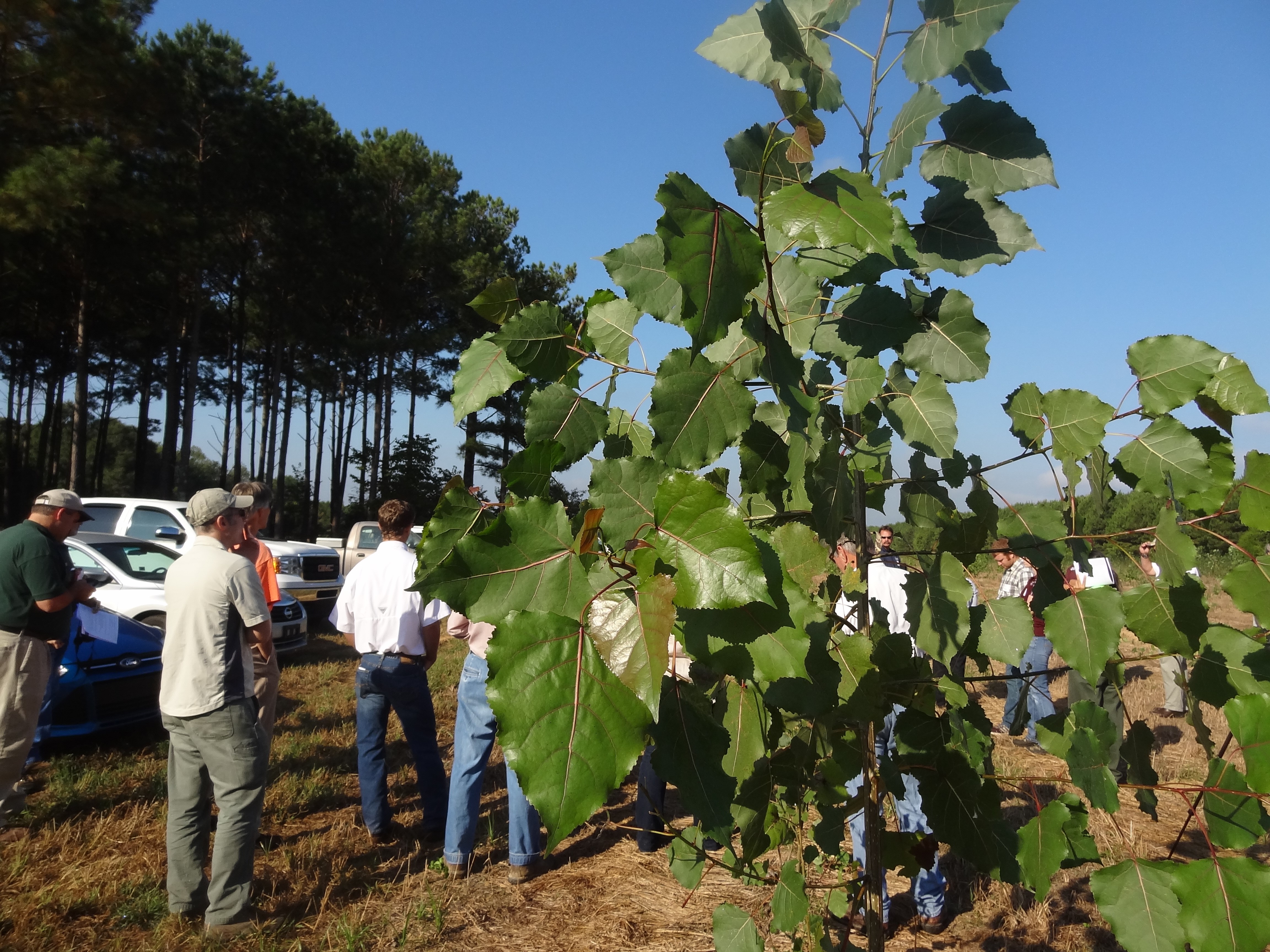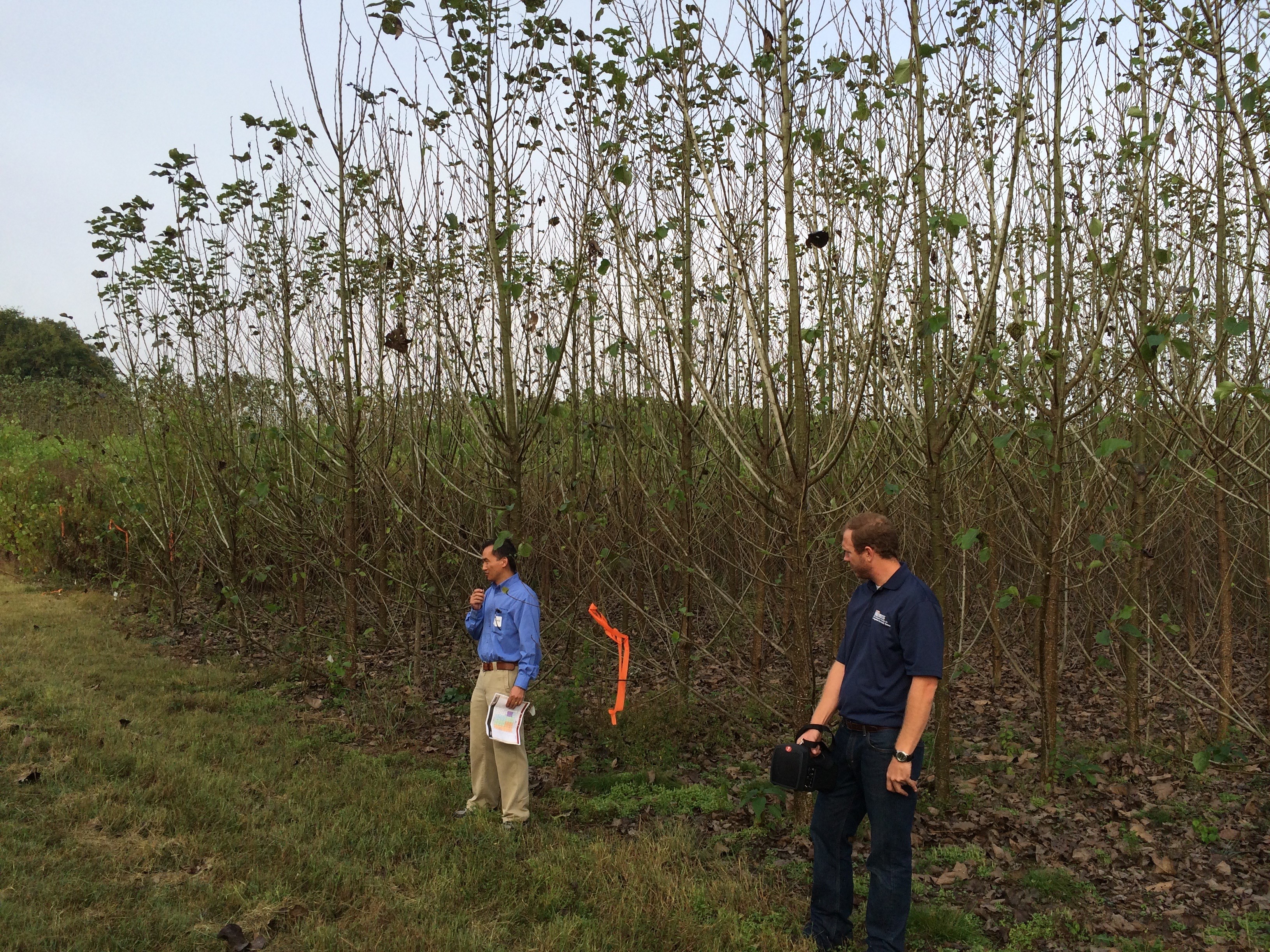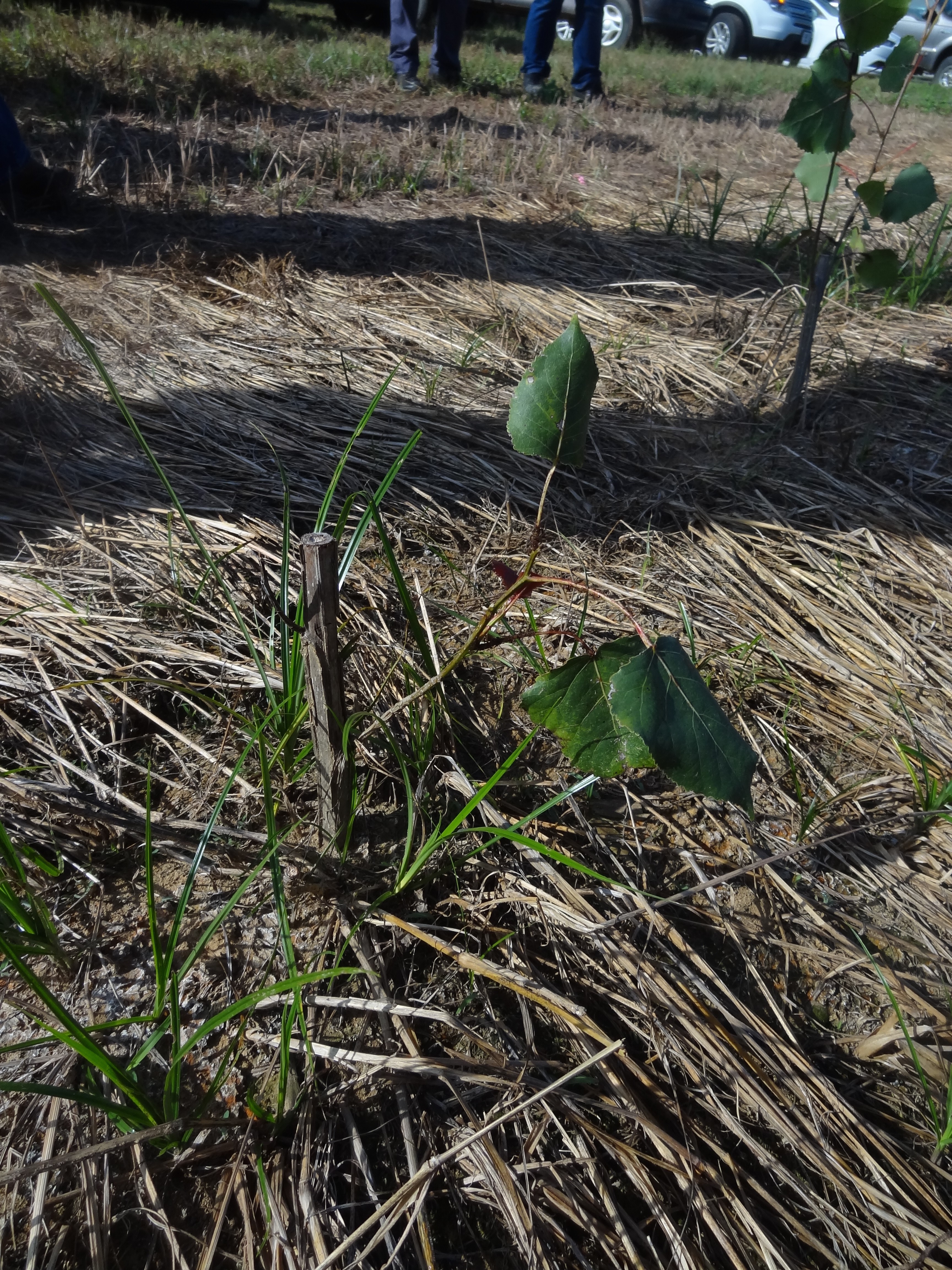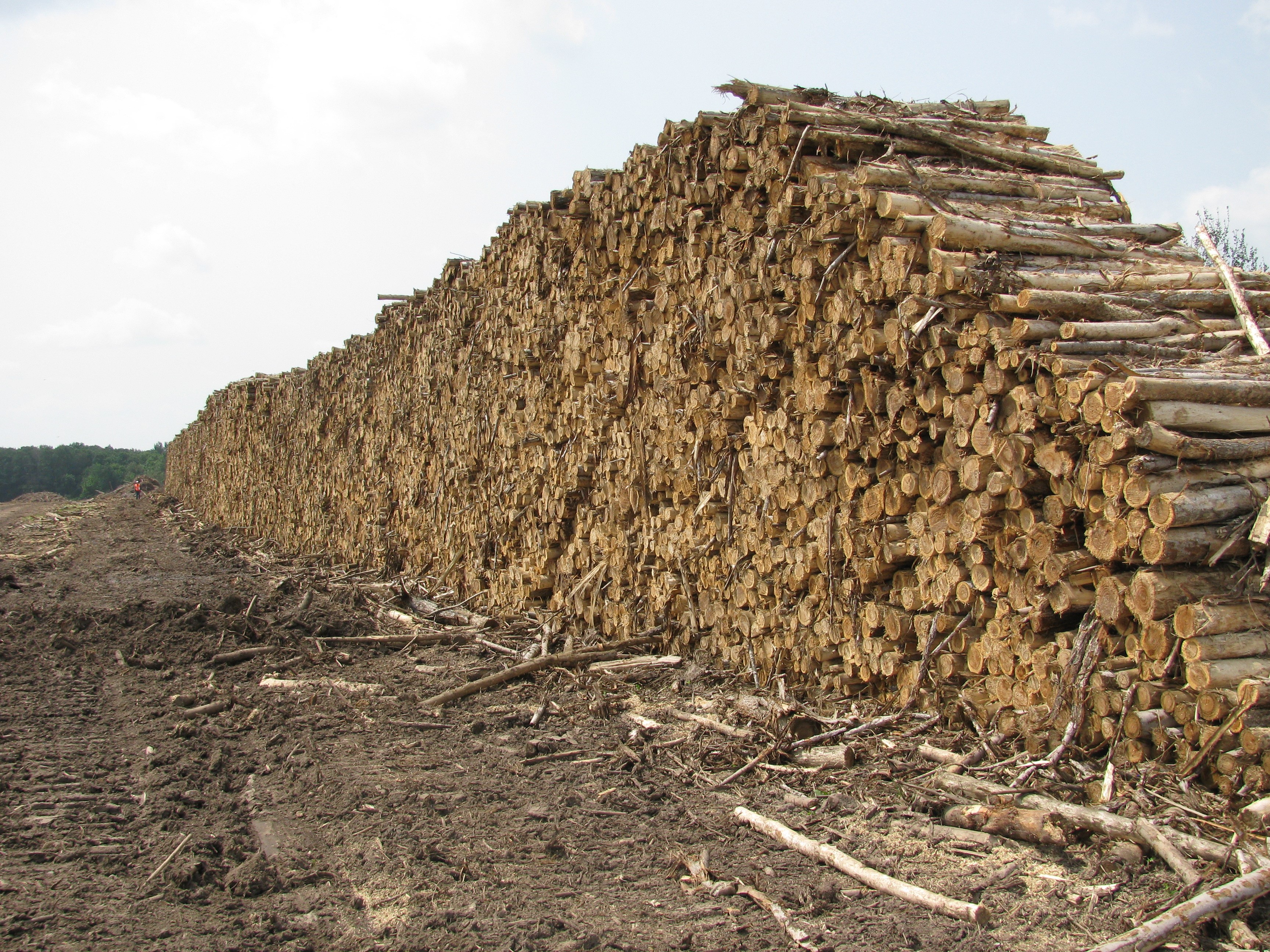Poplar (Populus sp.)
Introduction

Species Distribution
| Term | Definition |
|---|---|
| short rotation woody crops (SRWC) | Biomass management on a short rotation of anything less than 10 years, with high stem density and more intensive management than normal for pulpwood or sawtimber plantations |
| Coppice | A biomass management regime in which above ground tree biomass is harvested, and new stems sprout from the remaining stump.If the rotation is short enough, coppiced stands can also be considered SRWCs. |
| Populus | A genus of trees (Populus) that includes cottonwoods, aspens, and hybrid poplars. |
| Poplar | A common name given to trees in the genus Populus, as well as yellow poplar( Liriodendron tulipifera ). |
| Cottonwood | Common name for eastern cottonwood (Populus deltoides) in the Southeast.This native species grows throughout the eastern U.S.Also used to describe black cottonwood (P.trichocarpa) and Fremont’s cottonwood (P.fremontii) in the western U.S. |
| Hybrid poplar | A term that refers to Populus trees that have parents from different species.Species commonly used to create hybrid poplars are eastern cottonwood (Populus deltoides), black poplar (Populus nigra), Japanese poplar( Populus maximowitzii ), and black cottonwood (Populus trichocarpa). |

Hybrid poplars are often grown as short rotation woody crop( SRWC ) systems( Table 2 ).For SRWC plantings, trees are planted in rows and given treatment typical of agriculture, including weed and pest control, fertilization, and sometimes irrigation.Hybrid poplars in SRWC plantings in the southeastern United States can usually be harvested for pulp, or sometimes lumber, in 10 - 12 years.Hybrid poplars are also grown in coppice systems( Table 2 ).In coppice systems, the trees are grown for a few years, usually between 4 and 6, and then the stems are removed at the stump.The stumps re - sprout with multiple new stems that can match the size and form of the original stem.This cycle is then repeated every three to four years, providing landowners with regular income from sales of this material.
The composition of hybrid poplar wood also contributes to its potential as a feedstock.Hybrid poplar wood is made up of a relatively high proportion of cellulose, the component of wood that can be converted into the biofuel ethanol, and a low proportion of lignin, the other major component of wood, which cannot be converted readily into ethanol.Wood from hybrid poplar has lower sulfur content than other leading biofuel feedstock candidates, such as wheatstraw and switchgrass.Given that the combustion of sulfur can negatively impact air quality in the surrounding areas, this lower sulfur content makes hybrid poplar one of the more environmentally - friendly biofuel feedstock candidates.Hybrid poplar has a heating value of 8332 BTU per pound, which is superior to the heating values of many other feedstocks (Table 3 ).
Geographic Distribution
| Growing cycle | Coppice System |
| Planting stock | Commercially grown from clonal cuttings 10 - 18 inches in length |
| Age at first harvest | 3-6 years |
| Average Total Yield per Acre( non - irrigated, non fertilized | 0.9 dry tons/ac at 3 years, 1.7 dry tons/ac at 4 years, 2.8 dry tons/ac at 6 years, 3.5 dry tons/ac at 9 years |
| Average Total Yield per Acre( irrigated, fertilized ) | 3.1 tons/ac at 3 years, 5.2 dry tons/ac at at 4 years, 9.0 dry tons/ac at 6 years, 13.1 dry tons/ac at 9 years |

Native poplars grow readily across the temperate and sub - polar climate zones of North America; however, there are some challenges specific to growing hybrid poplar in the southeastern U.S.Hybrid poplar can only reach viable production levels on soils with both ample available moisture and sufficient drainage. This type of site is rare in the Southeast, making it difficult to find areas suitable for hybrid poplar plantations.Eastern cottonwood is found throughout the southeastern U.S.and commonly occurs on alluvial soils and bottomland areas.Hybrid poplars that can grow in this region, including Populus trichocarpa X Populus deltoides , P.deltoides X P.maximowiczii , and P.deltoides X P.nigra , grow well on the same types of sites as native cottonwoods, but some hybrids have faster growth rates during the first three years after planting or higher resilience to pest damage.
Numerous research trials have yielded insights into optimally managing hybrid poplar in the Lake States and the Pacific Northwest, but fewer trials have been conducted in the Southeast. Hybrid poplars are cultivated from crosses between Populus species to create specimens with desirable characteristics.These are then vegetatively propagated in clonal orchards from which cuttings are collected and stored for planting in other areas.These dormant, unrooted cuttings are typically ten to eighteen inches in length, depending on soil moisture availability, and are planted during the spring with one or two buds exposed above the ground surface.These cuttings are rejuvenated with water prior to planting and produce trees that are genetically identical to the parent tree.
A soil pH between 5.0 and 8.0 is recommended for favorable survival and growth rates. In the
southeastern United States, available water can often be the most limiting factor for hybrid poplar growth.
Nitrogen fertilization helps poplar stands reach maximum production much earlier than non-fertilized stands and
can significantly increase the amount of biomass produced at end of a rotation. For instance, nitrogen fertilization
at a rate of 107 pounds per acre per year increased the volume yielded by eastern cottonwood varieties by about 330% over
a 9-year rotation. The additional costs of fertilization can often be unfeasible for lower-revenue pursuits such as biomass production.
Hybrid poplars have been successfully planted on reclaimed mine sites that ad biosolids (solid,
organic materials removed from municipal wastewater) implanted underground. These biosolids raised the pH of the
soil and introduced additional nutrients for the trees to utilize. At the mine sites, the soil was disked after the
biosolids were buried 1.5 feet below the ground surface in order to evenly distribute them throughout the test area.
This method was able to match the yields of poplars grown on less degraded sites while remediating some of the damage
caused by prior mining activities.
Growth Rate
| Feedstock | Heating Value (BTU per pound) |
|---|---|
| Hybrid poplar | 8,332 |
| Switchgrass | 8,014 |
| Wheatstraw | 7,528 |
| Eastern cottonwood | 6,991 |

Hybrid poplars stands reach maturity and begin to experience increased mortality between fifteen and twenty years of age; however, stands are often harvested years before reaching maturity, even as early as three years after planting.In a study conducted by researchers at North Carolina State University, the growth rates of hybrid poplars proved to be two to three times as fast as those of green ash or sweetgum grown on similar sites.
Yield
Hybrid poplars grown in short-rotation or coppice systems can be harvested as early as 3 years after planting.The age at first harvest can be influenced by a number of factors, including the site quality and the landowner’s desired rate of return.Hybrid poplar test plots installed by researchers from the USDA Forest Service in the Upper Coastal Plain of South Carolina yielded 3.1 dry tons of biomass per acre three years after planting. Delaying harvest until six years after planting increased yields to up to 9 dry tons per acre. Other research from the University of Tennessee suggested an average 7 - 9 dry tons per acre on a 3 - 5 year rotation. These yields were produced by ST66 and S7C15 eastern cottonwood clones produced by Crown Vantage Corp. It is important to always keep in mind that hybrid poplar plantation yields are variable and are highly dependent on climate, site quality, and management intensity.
Conclusion
Hybrid poplar has great potential in the southeastern United States as a biomass feedstock. Its fast growth rate and abundant biomass growth make it a desirable bioenergy crop. There are some constraints for its establishment, including the current lack of markets for biomass.There is still a need for proper infrastructure to transport and process the biomass, without which the economic returns for planting it as a feedstock will be greatly diminished.Despite these challenges, there is great potential in the future for hybrid poplar as a biofuel feedstock.References
- Amichev, B.Y., M.Johnston, and K.C.J.Van Rees. 2010.Hybrid poplar growth in bioenergy production systems: Biomass prediction with a simple process - based model( 3PG ).Biomass and Bioenergy 34: 687 - 702.
- Brunner, A., J.Munsell, J.Gagnon, H.Burkhart, C.Zipper, C.Jackson, A. Fannon, B.Stanton, and R.Shuren. 2009. Hybrid Poplar for Bioenergy and Biomaterials Feedstock Production on Appalachian Reclaimed Mine Land. Virginia Tech, Blacksburg, VA.Powell River Project Research and Education Program Progress Reports.
- Coyle, D.R., D.P.Aubrey, and M.D.Coleman. 2016.Growth responses of narrow or broad site adapted tree species to a range of resource availability treatments after a full harvest rotation.Forest Ecology and Management 362: 107 - 119.
- Davis, M., J.Wright, and T.Gallagher. 2015.Sustainable Production Practices of Short Rotation Woody Crops in the Southeastern United States: A Guidebook for Cottonwood and Poplar.University of Tennessee Institute of Agriculture. 38 p.
- Felix, E., D.R.Tilley, G.Felton, and E.Flamino. 2007.Biomass production of hybrid poplar (Populus sp.) grown on deep - trenched municipal biosolids.Ecological Engineering 33: 8 - 14.
- Nichols, E.and D.Hazel.Hybrid Poplars for Bioenergy.North Carolina Cooperative Extension.Available at http://www.ncsu-feop.org/BioField-Day/Materials/Hazel_Nichols_Poplar.pdf .
- Sannigrahi, P.and A.J.Ragauskas. 2010.Poplar as a feedstock for biofuels: A review of compositional characteristics.Biofuels, Bioproducts,and Biorefining 4: 209 - 226.
- Townsend, P.A., S.P. Kar, and R.O. Miller. 2014. Poplar (Populus spp.) Trees for Biofuel Production. http://articles.extension.org/pages/70456/poplar-populus-spp-trees-for-biofuel-production/ accessed February 2016.
- Yemshanov, D. and D. McKenney. 2007. Fast-growing poplar plantations as a bioenergy supply source for Canada. Biomass and Bioenergy. 32: 185-197.
Prepared By
Connor McDonald, David Coyle, William Hubbard and Leslie Boby